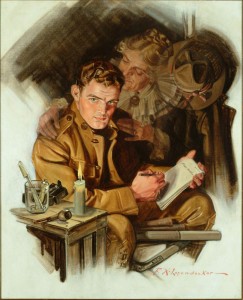
Frank Xavier Leyendecker (1877-1924)|The Letter Home, c.1918|Cover illustration for Country Gentleman (February 23, 1918)|oil on canvas|Delaware Art Museum, F. V. du Pont Acquisition Fund, 1983-128
Like any person gone off to war, in quiet moments their thoughts often turn to home. For this 1918 cover for Country Gentleman magazine Frank Xavier Leyendecker, younger brother of the illustrator J. C. Leyendecker, carefully crafted the image of the young World War I soldier sitting on the edge of his cot inside his tent at a makeshift table being comforted by thoughts of his mother. While there is no tent to be seen, the shaded background is laid on the canvas to imply the peaked interior space of a tent.
Notice how vast the difference in age there seems to be between the boy and mother. This reflects the late 19th–early 20th century perspective of the difference between the look of a 20-year old bride and her 50-year old mother persona. This mother is already on her way to being grandmotherly with her flaxen hair beginning to gray at her temples and her once taut skin now lined and turning jowly; her hands are thickened with age and work. As we can imagine from the facial structure still evident, she once must have been a beauty. In her lace cuffs and fichu pinned at her neck, the imagined mother image embraces “her boy.”
The young infantryman seems to be new to the battle, as indeed was true, for American soldiers did not join the war officially until mid-1917, after the May Congressional authorization for the Federal government to draft men for the armed forces. American troops did not arrive in France to join the battle until the beginning of July 1917. This soldier’s recent arrival can be inferred in the cleanliness and good repair of his uniform, the longish pencil in his hand, the candle only slightly burned down, and the aura of newness about his kit seen on the wooden crate desk and night stand. There are no frayed laces seen below the knees of his breeches. This is an image of a relaxed moment, reinforced by the fact that below the doughboy’s knees, his breeches are not wrapped by puttees, the strips of cloth wound round the lower leg to provide protection and support.
Like a good character actor, Leyendecker’s soldier’s chiseled good looks make him appear manly while his facial expression reveals him as tender. The neatness of his curly hair reminds us that men of that day often used a grease-derived product called pomade, or the brand Brilliantine, to give their hair a glossy well-groomed appearance.
Even without the period clothing the dating of this image could be guessed at by the soldier’s use of the opening appellation, “Dear Mother,” on his letter. At the turn of the 21st century we are more likely to use the title of Mom to address our female parent. At the turn of the 20th century Mom as a colloquial abbreviation of Momma began to be used but did not become commonplace until the 1940s as a slangy jivey short form. Before that ‘Mother’ was the preferred term used for American matriarchs.
September 17, 2009
By Joyce K. Schiller, Curator, Rockwell Center for American Visual Studies
Norman Rockwell Museum






